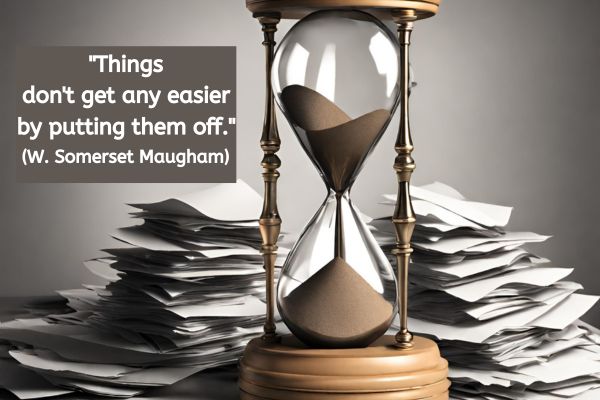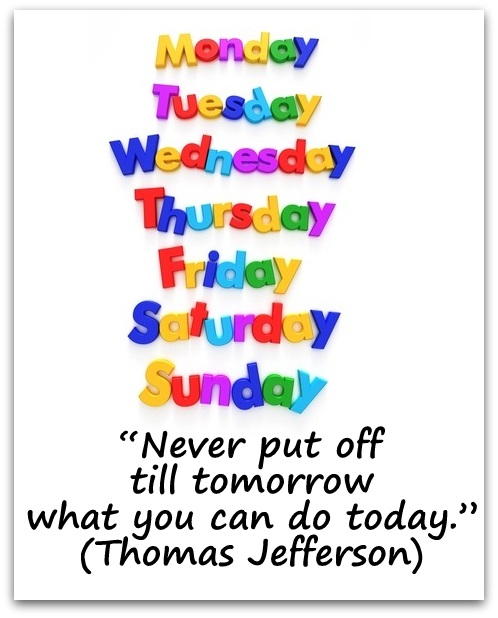By Stever Robbins
This week’s guest post takes the form of a Question and Answer session all about 9 steps to work less and do more.
Why do we procrastinate? What are some simple tips for beating procrastination?
Thinking causes procrastination. No, really. We build up tasks in our mind, thinking they’ll be huge, unachievable,or unpleasant. The remedy is to stop thinking and just start acting. Your brain will still get in your way, however. While you’re filling out your procrastinated expense reports, your brain will distract you with worries that you’re making no progress on the novel you’ve been procrastinating.
As I mention in my book, you can make your brain happy by speed-dating your tasks. List what you’re procrastinating. Start at the top and work on each task for exactly five minutes, then move to the next task. Use a timer to be precise. When you’re done, take a 5-10 minute break and do it again. Five minutes is short; your brain will let you do it. Since you’re hitting several of your procrastinated tasks, your brain knows you’ll get to your other tasks just five minutes from now. It frees you to focus completely on the task in front of you, yet guarantees you’ll go on to make progress on everything that’s important.
Your career background includes a lot of technology companies, but Step 3 of your 9 Steps to Work Less and Do More is called “Conquer Technology”. Why doesn’t technology automatically make us more productive? How can we use it to become more productive?
Don’t get me wrong; some technology really delivers on its promise. But often, technology saves effort in one place while adding effort in others. For example, each new gadget packs more capability into each device. What makes it attractive and fun also makes it distracting and kills our productivity.
Technology is a tool, nothing more, and nothing less. When a carpenter uses a screwdriver, she picks it up, uses it, and puts it down again. That’s how you use tools. Treat your technology the same way. Instead of being married to it everywhere you go, divorce your technology. Have it around, just not in front of you. Do your thinking on paper. Decide what you need to do. Then get out the tools to do it. If you need to do something on computer—like send email—get up, walk over to your computer, open the email program, send the email, close the program, and walk back to your main work area. By keeping each task distinct, you’ll learn to use your computer as a tool. Instead of being a distraction, it becomes a superb way of amplifying your focus. In that Step 3 of the book, I explained how I evaluate all of my gadgets to make sure they are delivering on their work-less-do-more promise; I suggest everyone do the as me.
Does being organized automatically mean you’re getting more done?
Being organized means you have a place for everything and everything goes in its place. When you’re disorganized, everything you do has the added burden of your having to search for the tools need to do it. For example, when you’re disorganized, writing a Thank You card is an adventure. You have to brave your Supply Pile. You hunt for 5 minutes to find the crumpled paper bag where you stuffed those Thank You cards. You start writing … only to find you’re out of stamps. A 10-minute trip to the Post Office, later your cards are ready to go. If you’re organized, you get out your Thank You cards and stamps. You write the Thank You card, stamp the envelope, and toss it in mailbox. Elapsed time: 30 seconds, instead of 15 minutes and 30 seconds.
If you use the 15 minutes you saved to get more done, then being organized helps you get more done in the same amount of time. Otherwise, you’re getting the same done in less time, freeing up the extra time to do something awesome. Like eat Oreo Ice Cream Cake. That’s one way being physically organized can help you be more productive. I also offer advice on how to organize your days and brain better in the book too.
In your book, you recommend people not consider all their options. How can this help someone get more done?
We love choice! We believe more choice means more happiness and more movement towards our goals! The research on choice refutes this, however. Give us more than two or three choices and we become less likely to act and more likely to regret any choice we take.
In daily life, this means too many options stalls us, and we end up less happy with our choices. We make and re-make our decisions until we’ve spent more time and money making the decision than the decision is actually worth.
By limiting our options, we limit the research needed for the choice, and we’re more likely to keep moving forward. My example is buying a digital camera. I’ve needed one for three years now, but there are too many to choose from. If I simply limit my options to the first ten cameras that appear on the Consumer Reports web site, the decision becomes much easier. Will I get the best camera possible? Probably not. But I will get a camera and start doing the photography I need to get done. Without limiting my choices, I stay paralyzed and stressed.
Leverage is usually a term applied to finance? The final step of your 9 Steps to Work Less and Do More is called “Leverage”. What do you mean when you use the term?
Leverage is a physics term. A lever is a simple machine. You put in a small force on the long end of a lever and get a strong force out. In finance, leverage means using a small amount of your own money to borrow a much greater amount, so you get huge financial effects using only a small amount of money.
In Get-it-Done Guy’s 9 Steps to Work Less and Do More, I use leverage to mean doing a small amount of work and getting a huge result. Choose ways of working where you work less and get outsized results. For example, most of us scribble down a to-do list as a way of keeping track of what we have to do today. You can get leverage by jotting down that list in a format that someone else can understand. Then you can hire an assistant, give them your old to-do lists, and they can hit the ground running. You are doing a little more work by writing neater and maybe elaborating each item a bit. Your return is immense, though, because your to-do list enables you to free up time by delegating.
What is an action day? Shouldn’t every day be an action day?
An action day is one of my favorite tips in the book and a great way to get things done while bonding with a friend. Call a friend who wants to have a super-productive day. Get together in person or by phone, each bringing a list of things you want to get done. Commit to making progress and start working. Check in at the top of each hour, report your last hour’s progress, and declare your next hour’s plan. Your promise to each other gets you started, and the hourly check-ins keep you on track. I find in-person or phone works best for action days.
Every day can be an action day if you have people willing to play. I wrote the final draft of my book by holding five action days a week. The action days kept me going through the rough patches, and a couple of the regular attendees became friends! An action day is pretty intense, though, and I found that two each week was a good number.
What is the biggest hindrance to your personal productivity? How do you deal with it?
The internet. The web and email are a large part of my job, and they’re both distraction machines. The moment I open an email or visit a web site to do research, I risk hours of distraction. Its siren song is extremely seductive and hard to resist…
My solution is to divorce my technology as I described earlier. Rather than thinking of my computer as “my computer,” I think of it as a different tools, depending on my task. Sometimes it’s my typewriter, sometimes it’s my reference book, and sometimes it’s my newspaper. When I think of it in terms of the tool I need at the moment, it helps me stay focused on the current task.
… and when that fails, I use a freeware program called Freedom on my Mac to shut down my internet connection for a couple of hours.
If a person can make just one change to make themselves more productive, what would you recommend they change?
Definitely Step 1, which is Live on Purpose. Regularly stop and ask yourself why you’re doing what you’re doing. Then make sure what you’re doing is really the best way to reach that goal. I do this a dozen times a day. “Why am I surfing Facebook?” “I dunno. Habit.” “Ok, self, get back to work!”
Living on Purpose goes far beyond your moment-to-moment tasks, however. I used to go to four or five business conferences each year. Why? “I’m doing important business development,” was my answer. Year, right. When reviewing my client list, I realized not a single client had come from attending a conference. My clients had only come from speaking at conferences. Now, I only attend conferences where I’m speaking, or if there’s some other compelling reason to be there.
You recommend that people schedule interruptions. How is this possible?
You schedule interruptions by setting aside a time block each day for dealing with interruptions. If you’re interrupted, quickly decide if it’s a show-stopping emergency. If not, jot it down on your “Interruptions” list. Wait until your scheduled interruption time and work on it then. If Bernice drops by, asking you to review a memo she’s written, just say, “I would be happy to. I’m busy right now. How about if I get back to you a little after 4 p.m.?” When your interruption time arrives, her memo will be on your list and you can handle it then. Often if the interruption is someone with a problem, they’ll solve it themselves when you make yourself their convenient rescue service.
Interruptions will take your time one way or another. If you schedule them, at least you can get work done in the meantime.
About the Author/ Further Resources
Stever Robbins is a serial entrepreneur, the author of Get-it-Done Guy’s 9 Steps to Work Less and Do More, host of the #1 iTunes business podcast The Get-it-Done Guy, and an adjunct lecturer at Babson College. He is currently working on his 10th startup.
Stever holds regular action days. If you’d like to be on the announcement list, visit http://www.SteverRobbins.com/actiondays. Announcements of new action days are sent out once or twice a month.






 Julia Neiman is the Founder of Transform For Life, an online coaching program for teens, and Executive Director of Group Home Consultants, a nonprofit that provides independent living skills training to transition age foster youth.
Julia Neiman is the Founder of Transform For Life, an online coaching program for teens, and Executive Director of Group Home Consultants, a nonprofit that provides independent living skills training to transition age foster youth.